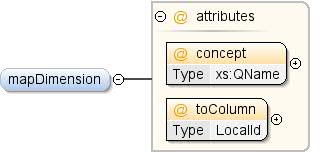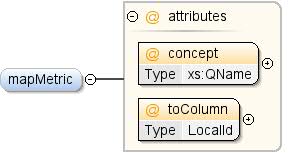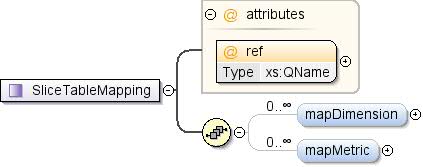Komponente: SliceTableMapping
Mit Sammlungen den Überblick behalten
Sie können Inhalte basierend auf Ihren Einstellungen speichern und kategorisieren.
| Namespace |
http://schemas.google.com/dspl/2010 |
| Annotationen |
Eine Zuordnung zur ID der Spalte, die die Werte eines
die Dimension des Slice. Diese Zuordnung kann weggelassen werden, wenn die Tabellenspalte
die die Segmentdimensionswerte enthält, hat die Konzept-ID als Spalte.
id [ID]. Wenn das referenzierte Konzept aus einem externen Dataset stammt, wird die Zuordnung
kann weggelassen werden, wenn die ID der Spalte mit der lokalen ID der
-Konzept (d.h. ohne Präfix). |
| Diagramm |
 |
| Attribute |
| content: |
komplex |
| minOccurs (Mindestanzahl): |
0 |
| maxOccurs: |
unbegrenzt |
|
| Attribute |
| QName |
Typ |
Behoben |
Standard |
Verwenden |
Annotation |
| Konzept |
xs:QName |
|
|
erforderlich |
Die ID des zugeordneten Dimensionskonzepts. |
| toColumn |
LocalId |
|
|
erforderlich |
Die ID der zugeordneten Tabellenspalte. |
|
| Quelle |
<xs:element name="mapDimension" minOccurs="0" maxOccurs="unbounded">
<xs:annotation>
<xs:documentation>A mapping to the id of the column that contains the values
of a dimension of the slice. This mapping may be omitted
if the table column that contains the slice dimension
values has the concept id as its column id. If the referenced
concept comes from an external dataset, the mapping may be omitted
if the id of the column matches the local id of the concept
(i.e., without the prefix).</xs:documentation>
</xs:annotation>
<xs:complexType>
<xs:attribute name="concept" type="xs:QName" use="required">
<xs:annotation>
<xs:documentation>The id of the mapped dimension concept.</xs:documentation>
</xs:annotation>
</xs:attribute>
<xs:attribute name="toColumn" type="LocalId" use="required">
<xs:annotation>
<xs:documentation>The id of the mapped table column.</xs:documentation>
</xs:annotation>
</xs:attribute>
</xs:complexType>
</xs:element>
|
| Namespace |
http://schemas.google.com/dspl/2010 |
| Annotationen |
Eine Zuordnung zur ID der Spalte, die die Werte eines
des Slice. Diese Zuordnung kann weggelassen werden,
wenn die Tabellenspalte, die
die die Slice-Messwerte enthält, hat die Konzept-ID die Spalten-ID. Wenn
das referenzierte Konzept aus einem externen Dataset stammt, kann die Zuordnung
ausgelassen, wenn die ID der Spalte mit der lokalen ID des Konzepts übereinstimmt
(d.h. ohne Präfix). |
| Diagramm |
 |
| Attribute |
| content: |
komplex |
| minOccurs (Mindestanzahl): |
0 |
| maxOccurs: |
unbegrenzt |
|
| Attribute |
| QName |
Typ |
Behoben |
Standard |
Verwenden |
Annotation |
| Konzept |
xs:QName |
|
|
erforderlich |
Die ID des Konzepts des zugeordneten Messwerts. |
| toColumn |
LocalId |
|
|
erforderlich |
Die ID der zugeordneten Tabellenspalte. |
|
| Quelle |
<xs:element name="mapMetric" minOccurs="0" maxOccurs="unbounded">
<xs:annotation>
<xs:documentation>A mapping to the id of the column that contains the values
of a metric of the slice. This mapping may be omitted if
the table column that contains the slice metric values has
the concept id as its column id. If the referenced
concept comes from an external dataset, the mapping may be omitted
if the id of the column matches the local id of the concept
(i.e., without the prefix).</xs:documentation>
</xs:annotation>
<xs:complexType>
<xs:attribute name="concept" type="xs:QName" use="required">
<xs:annotation>
<xs:documentation>The id of the mapped metric concept.</xs:documentation>
</xs:annotation>
</xs:attribute>
<xs:attribute name="toColumn" type="LocalId" use="required">
<xs:annotation>
<xs:documentation>The id of the mapped table column.</xs:documentation>
</xs:annotation>
</xs:attribute>
</xs:complexType>
</xs:element>
|
Komplexer Typ: SliceTableMapping
| Namespace |
http://schemas.google.com/dspl/2010 |
| Annotationen |
Eine Zuordnung zu einer Tabelle, die Daten für eine
Slice. |
| Diagramm |
 |
| Verwendet von |
|
| Modell |
mapDimension* , mapMetric* |
| Children |
mapDimension, mapMetric |
| Attribute |
| QName |
Typ |
Behoben |
Standard |
Verwenden |
Annotation |
| Ref. |
xs:QName |
|
|
erforderlich |
Die Kennzeichnung der Tabelle, die Daten für die
Slice. |
|
| Quelle |
<xs:complexType name="SliceTableMapping">
<xs:annotation>
<xs:documentation>A mapping to a table that provides data for a slice.</xs:documentation>
</xs:annotation>
<xs:sequence>
<xs:element name="mapDimension" minOccurs="0" maxOccurs="unbounded">
<xs:annotation>
<xs:documentation>A mapping to the id of the column that contains the values
of a dimension of the slice. This mapping may be omitted
if the table column that contains the slice dimension
values has the concept id as its column id. If the referenced
concept comes from an external dataset, the mapping may be omitted
if the id of the column matches the local id of the concept
(i.e., without the prefix).</xs:documentation>
</xs:annotation>
<xs:complexType>
<xs:attribute name="concept" type="xs:QName" use="required">
<xs:annotation>
<xs:documentation>The id of the mapped dimension concept.</xs:documentation>
</xs:annotation>
</xs:attribute>
<xs:attribute name="toColumn" type="LocalId" use="required">
<xs:annotation>
<xs:documentation>The id of the mapped table column.</xs:documentation>
</xs:annotation>
</xs:attribute>
</xs:complexType>
</xs:element>
<xs:element name="mapMetric" minOccurs="0" maxOccurs="unbounded">
<xs:annotation>
<xs:documentation>A mapping to the id of the column that contains the values
of a metric of the slice. This mapping may be omitted if
the table column that contains the slice metric values has
the concept id as its column id. If the referenced
concept comes from an external dataset, the mapping may be omitted
if the id of the column matches the local id of the concept
(i.e., without the prefix).</xs:documentation>
</xs:annotation>
<xs:complexType>
<xs:attribute name="concept" type="xs:QName" use="required">
<xs:annotation>
<xs:documentation>The id of the mapped metric concept.</xs:documentation>
</xs:annotation>
</xs:attribute>
<xs:attribute name="toColumn" type="LocalId" use="required">
<xs:annotation>
<xs:documentation>The id of the mapped table column.</xs:documentation>
</xs:annotation>
</xs:attribute>
</xs:complexType>
</xs:element>
</xs:sequence>
<xs:attribute name="ref" type="xs:QName" use="required">
<xs:annotation>
<xs:documentation>The identifier of the table that contains data for the slice.</xs:documentation>
</xs:annotation>
</xs:attribute>
</xs:complexType>
|
| Namespace |
Kein Namespace |
| Annotationen |
Die ID des zugeordneten Dimensionskonzepts. |
| Typ |
xs:QName |
| Attribute |
| verwenden Sie zum Beispiel: |
erforderlich |
|
| Verwendet von |
|
| Quelle |
<xs:attribute name="concept" type="xs:QName" use="required">
<xs:annotation>
<xs:documentation>The id of the mapped dimension concept.</xs:documentation>
</xs:annotation>
</xs:attribute>
|
| Namespace |
Kein Namespace |
| Annotationen |
Die ID der zugeordneten Tabellenspalte. |
| Typ |
LocalId |
| Attribute |
| verwenden Sie zum Beispiel: |
erforderlich |
|
| Attribute |
|
| Verwendet von |
|
| Quelle |
<xs:attribute name="toColumn" type="LocalId" use="required">
<xs:annotation>
<xs:documentation>The id of the mapped table column.</xs:documentation>
</xs:annotation>
</xs:attribute>
|
| Namespace |
Kein Namespace |
| Annotationen |
Die ID des Konzepts des zugeordneten Messwerts. |
| Typ |
xs:QName |
| Attribute |
| verwenden Sie zum Beispiel: |
erforderlich |
|
| Verwendet von |
|
| Quelle |
<xs:attribute name="concept" type="xs:QName" use="required">
<xs:annotation>
<xs:documentation>The id of the mapped metric concept.</xs:documentation>
</xs:annotation>
</xs:attribute>
|
| Namespace |
Kein Namespace |
| Annotationen |
Die ID der zugeordneten Tabellenspalte. |
| Typ |
LocalId |
| Attribute |
| verwenden Sie zum Beispiel: |
erforderlich |
|
| Attribute |
|
| Verwendet von |
|
| Quelle |
<xs:attribute name="toColumn" type="LocalId" use="required">
<xs:annotation>
<xs:documentation>The id of the mapped table column.</xs:documentation>
</xs:annotation>
</xs:attribute>
|
| Namespace |
Kein Namespace |
| Annotationen |
Die Kennzeichnung der Tabelle, die Daten für die
Slice. |
| Typ |
xs:QName |
| Attribute |
| verwenden Sie zum Beispiel: |
erforderlich |
|
| Verwendet von |
|
| Quelle |
<xs:attribute name="ref" type="xs:QName" use="required">
<xs:annotation>
<xs:documentation>The identifier of the table that contains data for the slice.</xs:documentation>
</xs:annotation>
</xs:attribute>
|
Erstellt mit dem
oXygen XML Editor
Sofern nicht anders angegeben, sind die Inhalte dieser Seite unter der Creative Commons Attribution 4.0 License und Codebeispiele unter der Apache 2.0 License lizenziert. Weitere Informationen finden Sie in den Websiterichtlinien von Google Developers. Java ist eine eingetragene Marke von Oracle und/oder seinen Partnern.
Zuletzt aktualisiert: 2025-07-25 (UTC).
[[["Leicht verständlich","easyToUnderstand","thumb-up"],["Mein Problem wurde gelöst","solvedMyProblem","thumb-up"],["Sonstiges","otherUp","thumb-up"]],[["Benötigte Informationen nicht gefunden","missingTheInformationINeed","thumb-down"],["Zu umständlich/zu viele Schritte","tooComplicatedTooManySteps","thumb-down"],["Nicht mehr aktuell","outOfDate","thumb-down"],["Problem mit der Übersetzung","translationIssue","thumb-down"],["Problem mit Beispielen/Code","samplesCodeIssue","thumb-down"],["Sonstiges","otherDown","thumb-down"]],["Zuletzt aktualisiert: 2025-07-25 (UTC)."],[],["The `SliceTableMapping` complex type maps data from a table to a slice. It uses `mapDimension` to link dimension values to table columns and `mapMetric` to link metric values. Each mapping can be omitted if the concept ID matches the column ID. `mapDimension` and `mapMetric` require a `concept` ID (dimension or metric) and a `toColumn` ID (table column). The `ref` attribute in `SliceTableMapping` identifies the table providing the slice data.\n"]]



